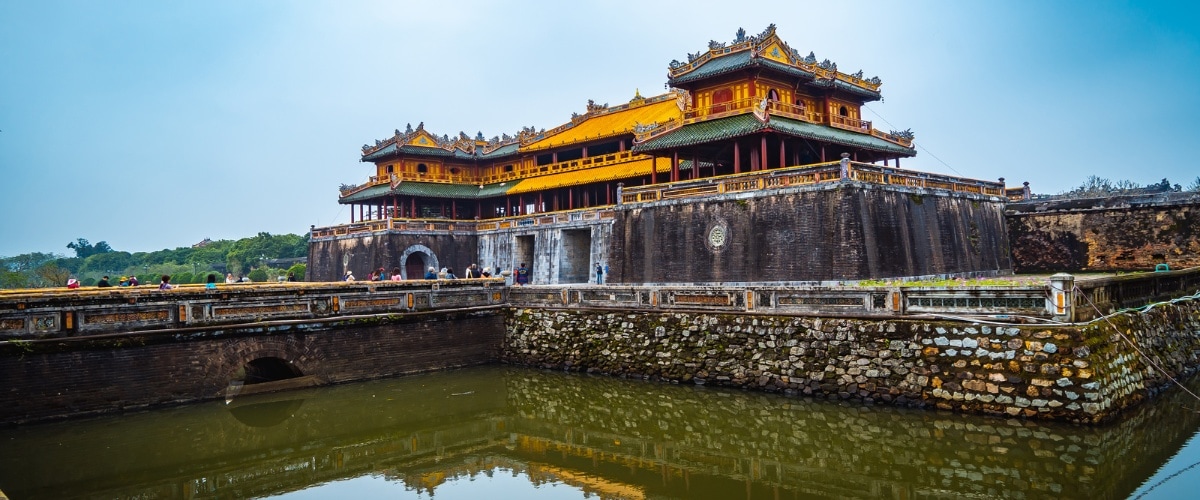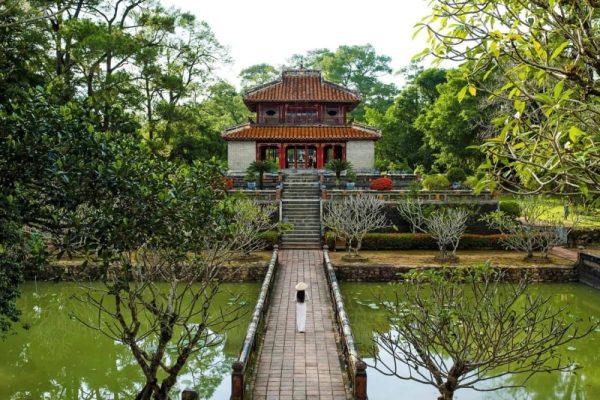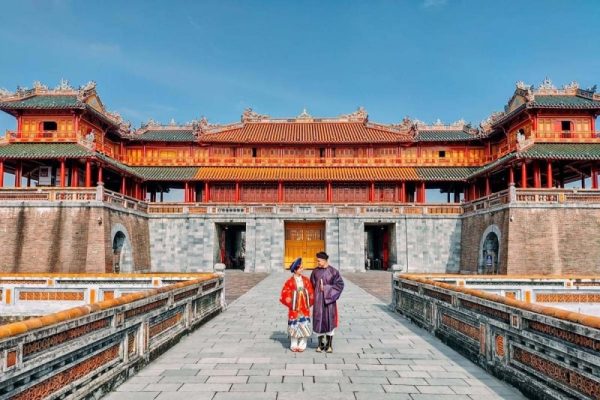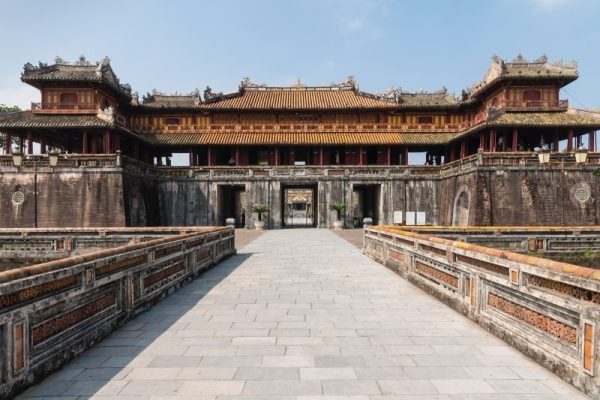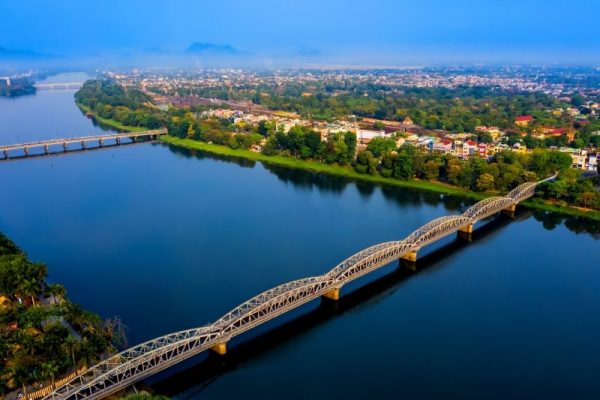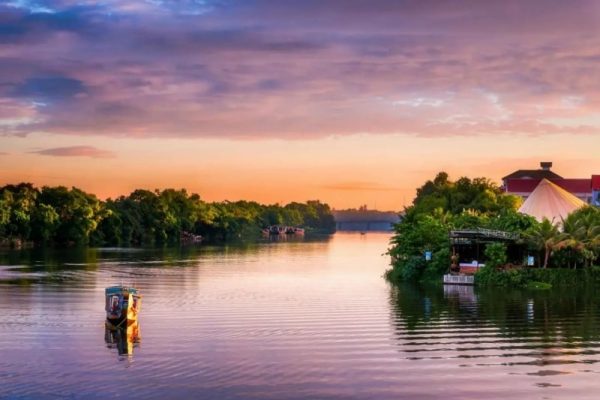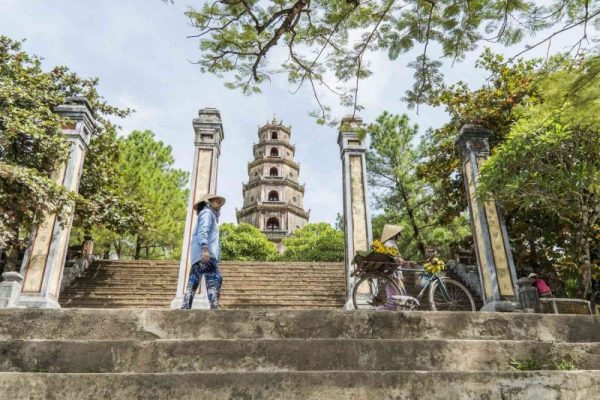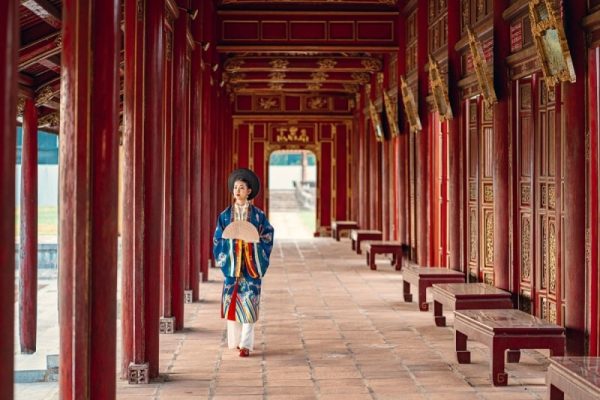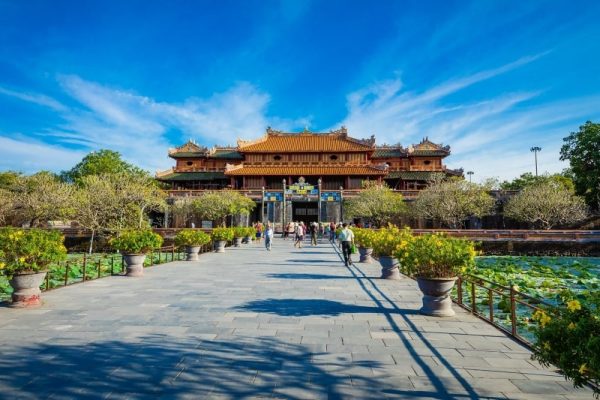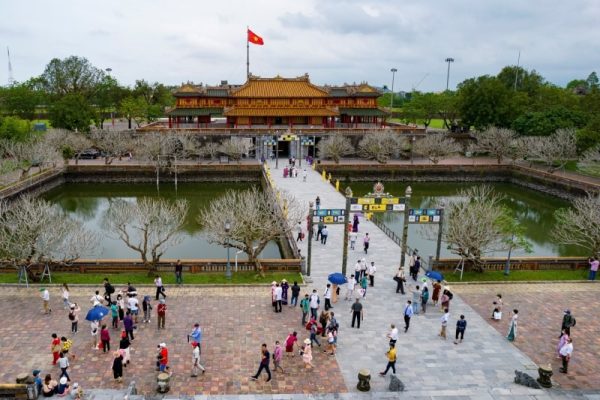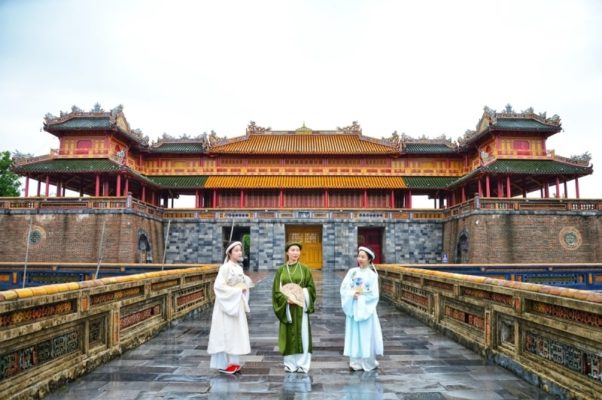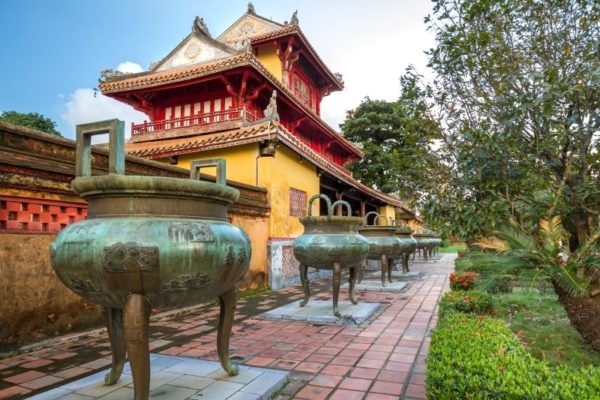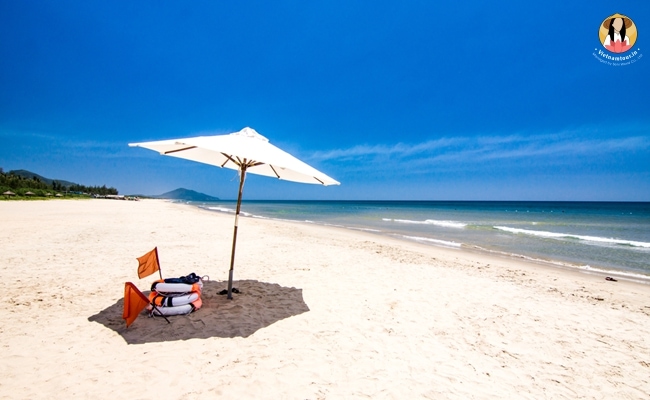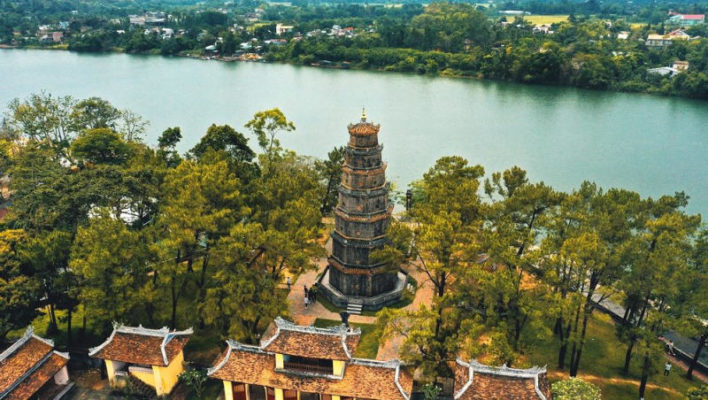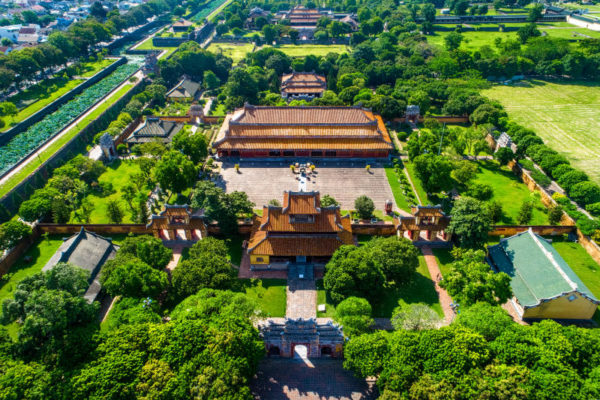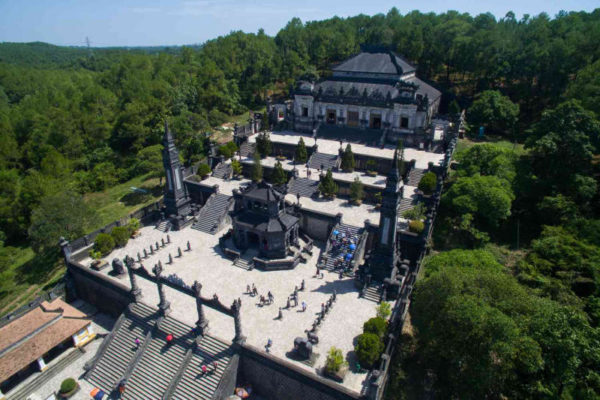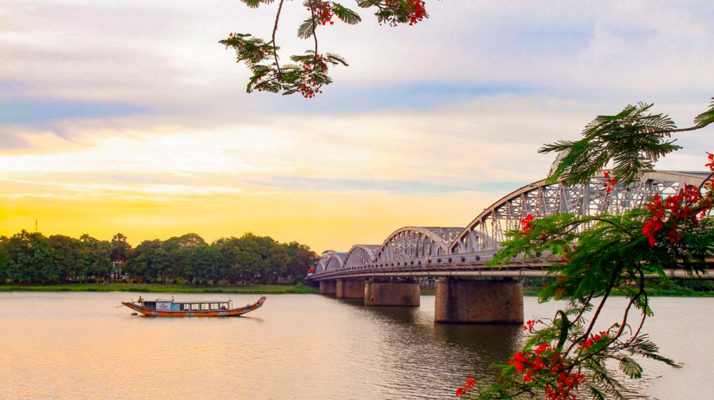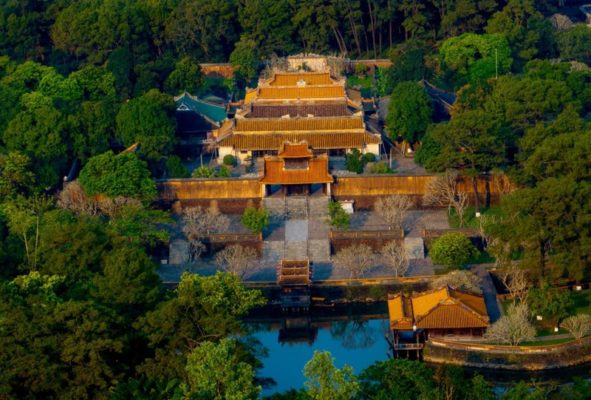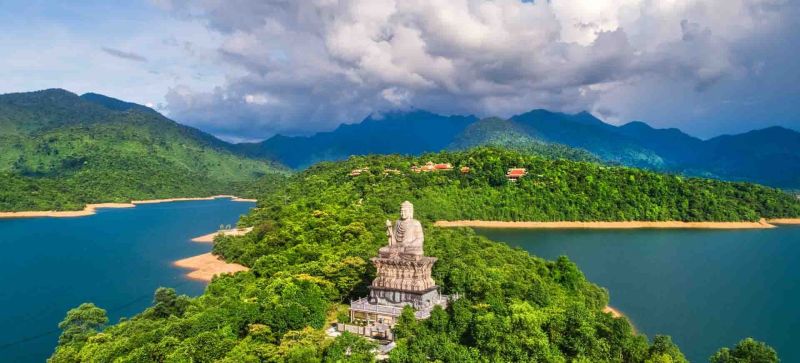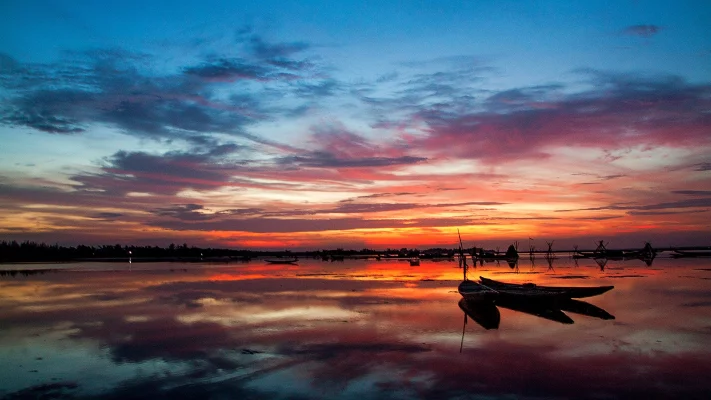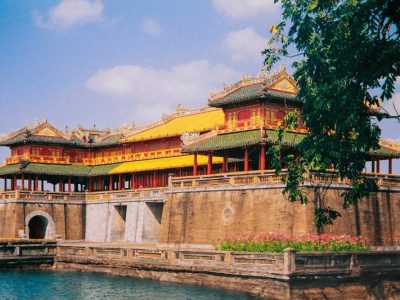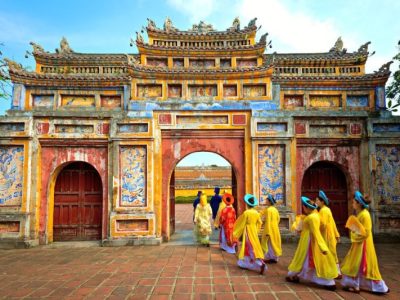Hue, a city nestled in Vietnam’s central region, boasts a rich cultural and historical heritage that is sure to hold anyone’s heart, especially for Indian travelers on their trip to Vietnam. The Nguyen Dynasty Kings established their feudal capital on the verdant riverbanks and rolling hills of Hue, and their imperial legacy still echoes through the city’s streets, monuments, and architecture. But that’s not all – Hue’s cuisine is a gastronomic delight, with its aromatic and flavorful dishes sure to tantalize your taste buds.
As you wander through the city, you’ll be charmed by the mossy pagodas, art deco mansions, and vibrant markets, all nestled amidst lush foliage. And then there’s the Huong River, which flows serenely through the heart of Hue, lending a tranquil and soothing vibe to the city. Hue is truly a feast for the senses, and a must-visit destination for ones seeking to immerse themselves in Vietnam’s cultural heritage.
Best time to visit Hue
The tourist season in Hue is from November of the previous year to April of the following year, with the best time to visit being the first three to four months of the year when the weather is cool. For those who love mountains, beaches, sunrises, and sunsets, the best time to visit is from June to August when the sun is at its best and the sea is the bluest.
Hue doesn’t have a dry season, only a rainy season and a less rainy season. The less rainy season usually lasts from March to August, with hot and oppressive weather. From September to January of the following year is the rainy season, with cold weather. Especially from October to November is the stormy season with heavy and persistent rains.
Spring lasts from the end of January to March, with beautiful weather, light sunshine, and occasionally chilly weather. From April to July, summer is hot in Hue, and it is an ideal tourist destination for beach lovers. During summer, the ancient city is decorated with the yellow of orchids, the pink of peach blossoms, and the purple of Bang Lang flowers. August marks the beginning of autumn, the most beautiful season of the year in Hue.
How to get to Hue from India
To reach Hue from India, the most convenient option is to take a flight to Da Nang International Airport, which is the closest airport to Hue. There are direct flights available from major Indian cities such as Delhi and Mumbai to Da Nang via connecting flights. From the airport, you can take a taxi or a shuttle bus to Hue, which is about 100 kilometers away.
Alternatively, you can take a train or a bus from major cities in Vietnam, such as Hanoi or Ho Chi Minh City, to Hue. The journey by train or bus can take anywhere from 12 to 18 hours, depending on the mode of transport and the route taken. Once you reach Hue, you can hire a motorbike or take a taxi to explore the city and its surroundings.
Getting around Hue
In Hue, to save costs and have the freedom to stop and explore along the way, it is recommended to rent a motorbike from your place of accommodation. The rental price for a standard motorbike is around 80,000 VND per day, while an automatic scooter costs around 130,000 VND per day, not including fuel.
One fun way to explore Hue that visitors should try is by taking a cyclo ride. The cyclo drivers also act as tour guides, taking visitors to popular destinations in the city such as Truong Tien Bridge and Dong Ba Market. At each destination, the cyclo will stop and allow visitors to explore on their own. Tours usually last for an hour, with prices ranging from 50,000 to 120,000 VND depending on the destination and travel time.
Attractions in Hue
Accommodation
Hotels in Hue are reasonably priced. It is recommended to book accommodation in the city center, close to the train and bus stations for easy transportation and access to local tourist attractions and food spots.
Homestays and hostels located in the city center such as A-Maze House, Sunshine, To Vo, and Tram offer rates of only 100,000 – 200,000 VND per night, which is suitable for solo travelers or groups of young friends. If traveling in a group, it is recommended to book in advance through online booking channels such as Booking, Agoda, Traveloka, Vntrip for better prices.
Hue also has a variety of luxury 4-5 star hotels and resorts. Famous brands include Banyan Tree Lang Co, Laguna Lang Co, Pilgrimage Village Boutique Resort & Spa, La Poet Hotel, Lapochine Beach Resort, Silk Path Grand Hue Hotel & Spa, Indochine Palace, Imperial Hotel Hue, Azerai La Residence Hue, and Vinpearl. Room rates range from approximately 2,000,000 – 8,000,000 VND per night.
Top things to do in Hue
- See Imperial Vietnam: Explore the palaces, pavilions, and theaters of the Hue Citadel and visit the tombs of emperors Tu Duc, Minh Mang and Khai Dinh.
- Eat like a king: Sample Hue’s world-class cuisine by visiting Dong Ba Market and trying their much-loved snacks like Banh Khoai and Banh Beo.
- Explore the city’s Buddhist roots: Visit Thien Mu Pagoda with its iconic seven-tiered tower and Tu Hieu Monastery, where Thich Nhat Hanh spent his days as a novice monk.
- Cycle in the rice paddies: Experience Hue’s beautiful countryside on a bike ride to the tile-roofed Thanh Toan Bridge, passing vegetable farms, footbridges, and flocks of ducks.
- Revisit colonial history: Take a stroll down Le Loi and see the remaining French influence in Hue’s architecture, including the art deco lines of La Residence Hotel and the stately crimson buildings of Quoc Hoc High School.
A foodie guide to Hue
Hue cuisine has long been famous for its delicious and aesthetically pleasing dishes. Some must-try dishes include bun bo, com hen, banh canh, banh beo, nam, loc, banh ep, banh uot thit nuong, and che. Each dish costs between 7,000 – 20,000 VND, while more filling options like bun bo and com niu cost around 30,000 VND. With just 100,000 – 300,000 VND, you can have a satisfying meal.
For drinks, try Tao Pho, soy milk, che, and banh loc with roasted pork. These drinks start at 15,000 VND and are available at many street vendors. Che Mo Ton Dich near Thuong Bac Park is a popular spot for Hue-style che.
To find authentic Huế cuisine, try looking for places located in small alleys or with old, simple signs. Places with names that start with “Mụ,” “Mệ,” “O,” or “Bé” are usually run by Huế natives and offer the most authentic dishes. Additionally, the older the owner, the better the food.
Here are some suggested food addresses in Hue:
- Bun bo Hue at 47 Nguyen Cong Tru, 20 Bach Đang, 17 Hung Vuong…
- Banh beo nam loc at O Le, alley 104/17/9 Kim Long
- Banh Hue at Luu Ngoc, 70 Kim Long
- Sua chua (yogurt) is available at many locations throughout the city.
- Grilled meat wrapped in rice paper at Huyen Anh, 52/11 Kim Long
- Com hen at Hoa Đong, 64 alley 7 Ung Binh
- Boiled meat rolled in sour shrimp sauce at the An Cuu riverbank
- Banh ep at 20 Nguyen Du
- Che Ong Lac, 36 Thanh Tinh
- Che Hue Kinh Do, 65 Tran Hung Dao
- Dong Ba Market
- Pho Tay Hue (walking street)
What to buy as a gift
If you want to buy souvenirs, consider Hue royal tea, lotus tea, nem cha (grilled pork roll), various kinds of fish sauce, dau tram (essential oil), dried banh ép, sesame candy, conical hats, or souvenir items with images of Hue’s landscapes.
Vietnam Itineraries with Hue
Customizable
11 Days 10 Nights
Siem Reap - Hanoi - Halong Bay - Da Nang - Hue - Hoi An
From Rs. 74,625
Per person (based on 2 adults)
Customizable
11 Days 10 Nights
Siem Reap - Hanoi - Halong Bay - Da Nang - Hue - Hoi An
From Rs. 74,625
Per person (based on 2 adults)
Customizable
11 Days 10 Nights
Siem Reap - Hanoi - Halong Bay - Da Nang - Hue - Hoi An
From Rs. 74,625
Per person (based on 2 adults)
FAQs about Hue
The most convenient way to travel from India to Hue is by air. You can take a flight from major Indian cities like Delhi, Mumbai, Bangalore, or Kolkata to Da Nang International Airport, which is the nearest airport to Hue. From there, you can hire a taxi or take a bus to reach Hue.
Hue offers a wealth of attractions that are perfect for Indian travelers. The Imperial Citadel, a UNESCO World Heritage Site, is a must-visit destination, where visitors can admire the majestic palaces, pavilions, and gardens of the Nguyen Dynasty. Another must-visit site is the Thien Mu Pagoda, a seven-story pagoda that dates back to the 17th century, located on a hill overlooking the Perfume River. The Tomb of Emperor Khai Dinh, with its intricate mosaics and European-influenced architecture, is another popular attraction.
For those interested in learning more about Hue’s history and culture, a visit to the Hue Museum of Royal Antiquities is recommended, where visitors can see a collection of royal artifacts and learn about the city’s imperial past. The Dong Ba Market is also worth a visit, where visitors can experience the bustling local market and try some of Hue’s famous street food.
Lastly, taking a boat ride along the Perfume River, enjoying the scenic views of the surrounding hills and pagodas, is a must-do activity while in Hue.

